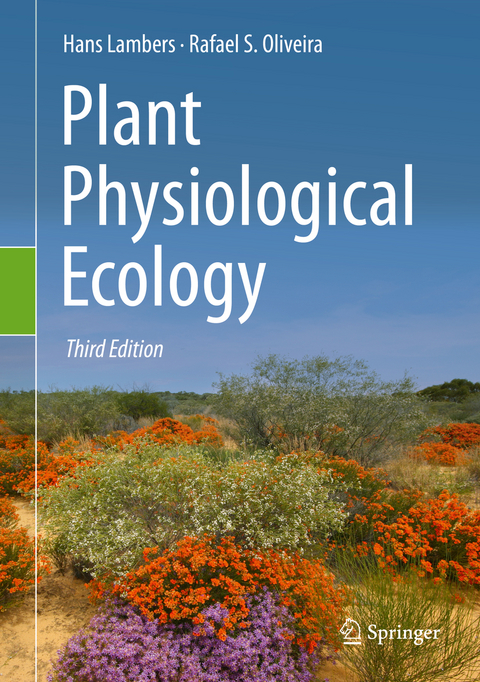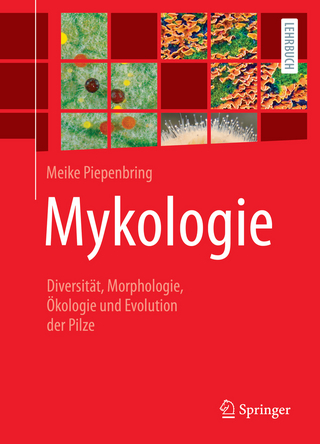
Plant Physiological Ecology
Springer International Publishing (Verlag)
978-3-030-29638-4 (ISBN)
Plant Physiological Ecology , Third Edition is significantly updated, with many full color illustrations, and begins with the primary processes of carbon metabolism and transport, plant water relations, and energy balance. After considering individual leaves and whole plants, these physiological processes are then scaled up to the level of the canopy. Subsequent chapters discuss mineral nutrition and the ways in which plants cope with nutrient deficient or toxic soils. The book then looks at patterns of growth and allocation, life history traits, and interactions between plants and other organisms. Later chapters deal with traits that affect decomposition of plant material and with the consequences of plant physiological ecology at ecosystem and global levels.
Plant Physiological Ecology , Third Edition features several boxed entries that extend the discussions of selected issues, a glossary, and numerous references to the primary and review literature. This significant new text is suitable for use in plant ecology courses, as well as classes ranging from plant physiology to plant molecular biology.
Hans Lambers is an Emeritus Professor of Plant Biology at the University of Western Australia, in Perth, Australia, and a Distinguished Professor at China Agricultural University, in Beijing, China. He did his undergraduate degree at the University of Groningen, the Netherlands, followed by a PhD project on effects of hypoxia on flooding-sensitive and -tolerant Senecio species at the same institution. From 1979 to 1982, he worked as a postdoc at the University of Western Australia, Melbourne University, and the Australian National University in Australia, working on respiration and nitrogen metabolism. After a postdoc at his alma mater, he became Professor of Ecophysiology at Utrecht University, the Netherlands, in 1985, where he focused on plant respiration and the physiological basis of variation in growth rate among herbaceous plants. In 1998, he moved to the University of Western Australia, where he focused on plant mineral nutrition, especially in legume crops and native species occurring on severely phosphorus-impoverished soils in a global biodiversity hotspot in southwestern Australia and southeastern Brazil. He has been Editor-in-Chief of the journal Plant and Soil since 1992 and featured on the first ISI list of highly cited authors in the field of animal and plant sciences (since 2002), and on several other ISI lists more recently. He was elected Fellow of the Royal Netherlands Academy of Arts and Sciences in 2003, and Fellow of the Australian Academy of Science in 2012. He received Honorary Degrees from three Universities and from the Academy of Sciences in China.
Rafael S. Oliveira is a Professor of Ecology at the University of Campinas (UNICAMP), Brazil. He did his undergraduate degree at the University of Brasília, Brazil, followed by a PhD on water relations of Amazonian and savanna trees at the University of California, Berkeley, USA. He worked as a postdoc from 2005 to 2007 at the National Institute of Space Research and the University of São Paulo in Brazil to improve the representation of key vegetation processes on climate models, followed by a project on the ecohydrology of tropical montane cloud forests. In 2007, he became Professor at UNICAMP. His research focuses on plant hydraulics, vegetation-climate feedbacks, and mineral nutrition of tropical plants. He is an Associate Editor for the journal Functional Ecology and Section Editor for Plant and Soil.
1. ASSUMPTIONS AND APPROACHES
Introduction-History, Assumptions, and Approaches
1 What is Ecophysiology?
2 The Roots of Ecophysiology
3 Physiological Ecology and the Distribution of Organisms
4 Time Scale of Plant Responses to Environment
5 Conceptual and Experimental Approaches
6 New Directions in Ecophysiology
7 The Structure of the Book
References
2. PHOTOSYNTHESIS, RESPIRATION, AND LONG-DISTANCE TRANSPORT
2A. PHOTOSYNTHESIS
1 Introduction
2 General Characteristics of the Photosynthetic Apparatus
2.1 The 'Light' and 'Dark' Reactions of Photosynthesis
2.2 Supply and Demand of CO 2 in the Photosynthetic Process
3 Response of Photosynthesis to Light
3.1 Characterization of the Light Climate under a Leaf Canopy
3.2 Physiological, Biochemical, and Anatomical Differences between Sun and Shade Leaves
3.3 Effects of Excess Irradiance
3.4 Responses to Variable Irradiance
4 Partitioning of the Products of Photosynthesis and Regulation by 'Feedback'
4.1 Partitioning within the Cell
4.2 Regulation of the Rate of Photosynthesis by Feedback
4.3 Sugar-induced Repression of Genes Encoding for Calvin-cycle Enzymes
4.4 Ecological impacts Mediated by Source-Sink Interactions
4.5 Petiole and Stem Photosynthesis
5 Responses to Availability of Water
5.1 Regulation of Stomatal Opening
5.2 The A - C i Curve as Affected by Water Stress
5.3 Carbon isotope Discrimination in Relation to Water-use Efficiency
5.4 Other sources of Variation in Carbon isotope ratios in C 3 Plants
6 Effects of Nutrient Supply on Photosynthesis
6.1 The Photosynthesis-Nitrogen Relationship
6.2 Interactions of Nitrogen, Light and Water
6.3 Photosynthesis, Nitrogen, and Leaf Life Span
7 Photosynthesis and Leaf Temperature: Effects and Adaptations
7.1 Effects of High Temperatures on Photosynthesis
7.2 Effects of Low Temperatures on Photosynthesis
8 Effects of Air Pollutants on Photosynthesis
9 C 4 Plants
9.1 Introduction
9.2 Biochemical and Anatomical Aspects
9.3 Intercellular and Intracellular Transport of Metabolites of the C 4 Pathway
9.4 Photosynthetic Efficiency and Performance at High and Low Temperatures
9.5 C 3 -C 4 Intermediates
9.6 Evolution and Distribution of C 4 species
9.7 Carbon isotope Composition of C 4 Species
9.8 Growth Rates of C 4 Species
10 CAM Plants
10.1 Introduction
10.2 Physiological, Biochemical and Anatomical Aspects
10.3 Water-use Efficiency
10.4 Incomplete and facultative CAM Plants
10.5 Distribution and Evolution of CAM Species
10.6 Carbon isotope Composition of CAM Species
11 Specialized Mechanisms Associated with Photosynthetic Carbon Acquisition in aquatic Plants
11.1 Introduction
11.2 The CO 2 Supply in Water
11.3 The Use of bicarbonate by aquatic Macrophytes
11.4 The Use of CO 2 from the Sediment
11.5 Crassulacean Acid Metabolism (CAM) in Water Plants
11.6 Variation in Carbon isotope Composition between Water Plants and between aquatic and Terrestrial Plants
11.7 The Role of aquatic Plants in Carbonate Sedimentation
12 Effects of the Rising CO 2 Concentration in the Atmosphere
12.1 Acclimation of Photosynthesis to Elevated CO 2 Concentrations
12.2 Effects of Elevated CO 2 on Transpiration Differential Effects on C 3 , C 4 and CAM Plants
13 Summary: What Can We Gain from Basic Principles and Rates of Single-Leaf Photosynthesis?
References
Box 2A.1: Mathematical Description of the CO 2 Response and further Modeling of Photosynthesis
Box 2A.2: Fractionation of Stable Carbon isotopes in Plants
Box 2A.3: Carbon-fixation and Light-Absorption Profiles inside Leaves
Box 2A.4: Chlorophyll fluorescence
Box 2A.5: The Measurement of Gas Exchange
2B. RESPIRATION
1 Introduction
2 General Characteristics of the Respiratory System
2.1 The Respiratory Quotient
2.2 Glycolysis, the Pentose Phosphate Pathway, and the Tricarbo
| Erscheinungsdatum | 22.01.2020 |
|---|---|
| Zusatzinfo | XXVII, 736 p. 354 illus., 237 illus. in color. |
| Verlagsort | Cham |
| Sprache | englisch |
| Maße | 178 x 254 mm |
| Gewicht | 1714 g |
| Einbandart | gebunden |
| Themenwelt | Naturwissenschaften ► Biologie ► Botanik |
| Naturwissenschaften ► Biologie ► Genetik / Molekularbiologie | |
| Naturwissenschaften ► Biologie ► Ökologie / Naturschutz | |
| Schlagworte | Allelopathy • Assimilat • Chloroplast • Energy balance • Mineral Nutrition • nitrogen • pathogen • Photorespiration • photosynthesis • Physiology • Plant Physiology • Roots • Transport • Water Stress |
| ISBN-10 | 3-030-29638-5 / 3030296385 |
| ISBN-13 | 978-3-030-29638-4 / 9783030296384 |
| Zustand | Neuware |
| Informationen gemäß Produktsicherheitsverordnung (GPSR) | |
| Haben Sie eine Frage zum Produkt? |
aus dem Bereich


